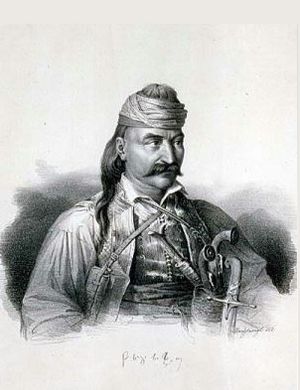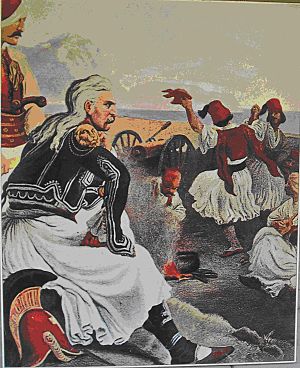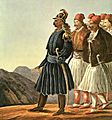Theodoros Kolokotronis facts for kids
Quick facts for kids
Lieutenant General
Theodoros Kolokotronis
|
|
|---|---|
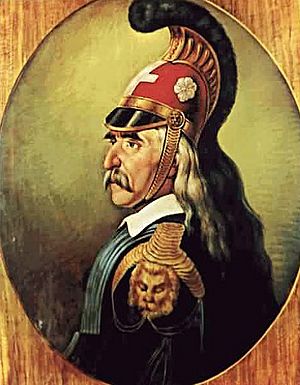
Theodoros Kolokotronis.
Portrait by Dionysios Tsokos. |
|
| Native name |
Θεόδωρος Κολοκοτρώνης
|
| Nickname(s) | O Geros tou Moria (The Old Man of the Morea) Ο Γέρος του Μοριά |
| Born | 3 April 1770 Ramοvouni, Messenia, Morea Eyalet, Ottoman Empire (now Greece) |
| Died | 16 February 1843 (aged 72) Athens, Attica, Kingdom of Greece |
| Buried |
First Cemetery of Athens
(37°57′47.38″N 23°44′16.35″E / 37.9631611°N 23.7378750°E) |
| Allegiance | |
| Service/ |
|
| Years of service | 1785-1843 |
| Rank | Major (British Army) General-in-Chief (Revolutionary Forces) Lieutenant General (Hellenic Army) |
| Unit | 1st Regiment Greek Light Infantry |
| Commands held | Greek Revolutionary Forces |
| Wars | Russo-Turkish War Greek War of Independence
|
| Spouse(s) | Aikaterini Karousou |
| Children | Panos Kolokotronis (son) Ioannis (Gennaios) Kolokotronis (son) Konstantinos (Kolinos) Kolokotronis (son) Panos Kolokotronis (son) Eleni Kolokotroni (daughter) Georgios Kolokotronis (son) |
| Relations | Konstantinos Kolokotronis (father) |
| Signature | |
Theodoros Kolokotronis (Greek: Θεόδωρος Κολοκοτρώνης; 3 April 1770 – 16 February 1843) was a famous Greek general. He was a main leader in the Greek War of Independence (1821–1829). This war was fought against the Ottoman Empire to make Greece free.
Kolokotronis's biggest victory was defeating the Ottoman army at the Battle of Dervenakia in 1822. In 1825, he became the commander of all Greek forces in the Peloponnese region. Today, Kolokotronis is remembered as one of the most important heroes of Greece's fight for independence.
Contents
Theodoros Kolokotronis: A Greek Hero
Early Life and Adventures
Theodoros Kolokotronis was born in Ramavouni, a mountain area in Messenia, Greece. He was baptized in the village of Piana. His family, the Kolokotroneoi, were known as klefts. Klefts were like warrior-bandits who lived in the mountains and fought against Ottoman rule.
He grew up in Libovitsi, Arcadia. His family was very strong and respected in the 1700s. A famous folk song from that time shows how proud and independent they were:
"On a horse they go to church,
On a horse they kiss the icons,
On a horse they receive communion
From the priest's hand."
His father, Konstantinos Kolokotronis, joined a rebellion against the Ottomans. This rebellion was supported by Catherine the Great of Russia. In 1780, his father and two uncles were killed fighting Ottoman soldiers. Theodoros was named after Fyodor Orlov, a Russian general.
Before the Greek Revolution, Theodoros Kolokotronis worked in different roles. He was a kleft (a warrior-bandit) and an armatolos (a Christian fighter working for the Ottomans). He also worked as a kápos (a local guard for rich Greek families). He became wealthy by stealing sheep and marrying a rich woman.
In 1805, he joined the Russian Navy during a war with the Ottomans. In 1806, he had to flee to the island of Zakynthos because of Ottoman attacks. When the British took over Zakynthos, he gained valuable military experience. He served in the 1st Regiment Greek Light Infantry and became a major in 1810. From his time in the British Army, he started wearing his famous red helmet.
While on the Ionian Islands, he learned about new ideas of freedom and revolution. He was greatly influenced by them:
I believe the French Revolution and what Napoleon did opened the eyes of the world. People didn't know much before. They thought kings were like gods and everything they did was right. Now, it's harder to rule people.
Fighting for Freedom: The Greek War of Independence
The Start of the Fight
Kolokotronis returned to mainland Greece just before the war officially began on March 25, 1821. He brought together many groups of klepht fighters from the Peloponnese. He tried to train and organize them into a proper army. In May, he was named archistrategos, which means commander-in-chief. He was 50 years old at this time. This led to his nickname O Geros tou Morea, meaning "The Elder of Morea." Morea was another name for the Peloponnese.
Kolokotronis's first big action was defending Valtetsi. This village was near Tripoli, where his army was gathering. Later, he also led the Greek forces during the Siege of Tripolitsa. After capturing Tripolitsa, he ordered a tree to be cut down. This tree was in the market-place where the Turks used to hang Greeks.
Capturing Important Forts
Next, he commanded Greek troops with Demetrios Ypsilantis in the siege of Nafplio. This siege started in September 1821. They also besieged Acrocorinth, which surrendered in January 1822. Later, they besieged the fortress of Patras starting in February 1822.
Greek forces took the port of Nafplio. The Ottoman soldiers in the town's forts were running out of supplies. However, the Greek government was disorganized and couldn't finish surrender talks. Then, a large Ottoman army started marching south to crush the Greek rebels. Government officials panicked and left Argos, trying to escape by sea at Nafplio. Only a small group of soldiers led by Demetrios Ypsilantis stayed to defend Larissa castle near Argos.
A Clever Leader
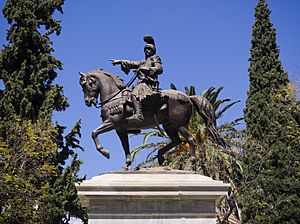
Kolokotronis gathered the klefts to help Ypsilantis. This was a difficult task because the government was falling apart. Also, the kleft groups were known for arguing a lot. Even the difficult Souliotes helped out. The Ottoman army from the north, led by Mahmud Dramali Pasha, had reached the plain of Argos. Larissa castle was a great position, controlling the whole plain. Dramali had to capture it before moving on. Taking the castle would be hard.
However, Dramali didn't know one weakness: Larissa had no natural spring. Water had to come from cisterns. It was July, and no rain was falling to fill them. Ypsilantis tricked the Ottomans for as long as he could. But by the end of the month, he had to sneak his men out at night. Dramali's men took the castle the next day. He was now free to march his troops towards the coast for supplies. The Greeks had used a scorched earth tactic, destroying food and resources. This made it hard for the large Ottoman army to find food. Ypsilantis's defense gave Kolokotronis and the klefts valuable time.
Dramali was upset to find his supply ships blocked by the Greek fleet. Admiral Andreas Miaoulis led the successful blockade. Dramali decided to retreat towards Corinth through the Dervenaki Pass. This was exactly what Kolokotronis wanted. In August 1822, his faster guerrilla fighters trapped the Ottomans in the pass. They destroyed the Ottoman army in the Battle of Dervenakia.
The Ottoman Sultan Mahmud II in Constantinople was devastated. He had to ask Muhammad Ali Pasha, the ruler of Egypt, for help. The Greeks continued to besiege the forts at Nafplio, which fell in December. It is said that Kolokotronis rode his horse up the steep slopes of Palamidi to celebrate his victory. A statue in the town square shows him in his Greek Light Infantry uniform, which he liked to wear.
Challenges After the War
Political Troubles
From December 1823 to February 1825, Kolokotronis was involved in civil wars between different Greek groups. When his group was defeated, he was put in prison on Hydra in March 1825. He was released only when an Egyptian army, led by Ibrahim Pasha, invaded the Peloponnese. His oldest son, Panos Kolokotronis, died during the second civil war.
Facing Ibrahim Pasha
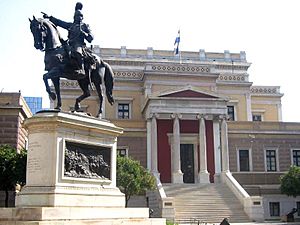
Ibrahim was experienced in fighting guerrilla groups. His soldiers had modern equipment and were trained by European experts. The Sultan had promised Ibrahim the island of Crete if he could defeat the rebels. Ibrahim burned his way through the Peloponnese, taking much land. However, this destruction made people in Western Europe angry, which hurt the Ottomans in the long run.
The islands of Sphacteria and Navarino had already fallen to Ibrahim. Kolokotronis also had to be careful of political plots while facing this new threat. Kolokotronis decided not to fight Ibrahim in open battles. Instead, he used guerrilla tactics and a scorched earth policy. This meant destroying resources so the enemy couldn't use them. Because he had limited resources, he couldn't stop all the destruction Ibrahim caused. Still, in 1825, he was made commander-in-chief of Greek forces in the Peloponnese. This was because of his military skill and his many services to Greece.
Later Years and Lasting Impact
After the war, Kolokotronis supported Count Ioannis Kapodistrias, who was the first governor of Greece. He also wanted Greece to be allied with Russia. When Kapodistrias was killed in 1831, Kolokotronis supported Prince Otto of Bavaria as the new King of Greece. However, he later disagreed with the Bavarian-led government that ruled for Otto. In 1834, he was accused of plotting against the government and was sentenced to death. But he and his friend Dimitrios Plapoutas were pardoned in 1835.
Theodoros Kolokotronis died in 1843 in Athens. This was one day after his son Konstantinos's wedding and a celebration at the Royal Palace with King Otto.
In his later years, Kolokotronis learned to write so he could complete his memoirs. These writings are very popular in Greece and have been translated into other languages. Kolokotronis's famous red helmet, along with his weapons and armor, can be seen today at the National Historical Museum of Greece in Athens. Besides the statue in Nafplio, there is another one in Athens. It is in front of the Old Parliament building on Stadiou Street, near Syntagma Square.
Legacy
- Kolokotronis is also the name of military barracks near Tripoli.
- Κοlokotronis was so famous in popular culture that one can find references about him in strange places, like a gravure sculpted by knife on a stony sterna inside a cave in one of the holes in mount Ntaouli opposite the village Lyrkeia in the valley of the Inachos river.
- A portrait of Kolokotronis was depicted on the Greek 5000 drachmas banknote of 1984–2002.
- Theodoros Kolokotronis Stadium (Greek: Γήπεδο Θεόδωρος Κολοκοτρώνης), formerly known as Asteras Tripolis Stadium, is a football stadium in Tripoli, Greece. The stadium is the home stadium of Asteras Tripolis.
Gallery
See also
 In Spanish: Theodoros Kolokotronis para niños
In Spanish: Theodoros Kolokotronis para niños


